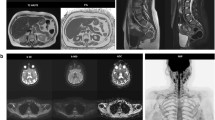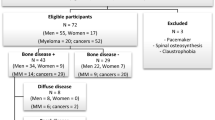Abstract
Purpose
To perform a survey among all members of the Italian Society of Medical and Interventional Radiology (SIRM) to assess how whole-body MRI (WB-MRI) is performed in oncologic patients in Italy.
Methods
On March 2019, we administered an online poll to all SIRM members about their use of WB-MRI in 2018 asking 15 questions regarding oncologic indications, imaging protocol, use of contrast media, experience in WB-MRI, duration of scan time and reporting time.
Results
Forty-eight members participated to the survey. WB-MRIs/total MRIs ratio was 1%. Lymphoma was the most common indication (17/48, 35%), followed by myeloma and prostate cancer, with these three tumors representing the most common indication in 39/48 of cases (81%). WB-MRI acquisition time and reporting time were 46–60 min in 22/48 centers (46%) and 20–30 min in 19/48 (40%), respectively. WB-MRIs were mostly performed in 1.5T scanners (43/48, 90%), with surface coils (22/48, 46%) being preferred to Q-body (15/48, 31%) and integrated coils (11/48, 23%). Contrast media were injected in 22/48 of the centers (46%), mainly used for breast cancer (13/22, 59%). DWI was the most used sequence (45/48, 94%), mostly with b800 (27/48, 56%), b0 (24/48, 50%) and b1000 (20/48, 42%) values. In about half of cases, radiologists started evaluating WB-MRI non-contrast morphologic sequences, then checking DWI and post-contrast images.
Conclusion
WB-MRI was mainly performed at 1.5T unit, with lymphoma, myeloma and prostate cancer having been the most common indications. The extreme variability in the choice of imaging protocols and use of contrast agents demonstrates the need of a standardization of WB-MRI application in clinical practice.




Similar content being viewed by others
References
Chien SH, Liu CJ, Hu YW et al (2015) Frequency of surveillance computed tomography in non-Hodgkin lymphoma and the risk of secondary primary malignancies: a nationwide population-based study. Int J Cancer 137:658–665. https://doi.org/10.1002/ijc.29433
Huang B, Law MW, Khong PL (2009) Whole-body PET/CT scanning: estimation of radiation dose and cancer risk. Radiology 251:166–174. https://doi.org/10.1148/radiol.2511081300
Lauenstein TC, Semelka RC (2006) Emerging techniques: whole-body screening and staging with MRI. J Magn Reson Imaging 24:489–498. https://doi.org/10.1002/jmri.20666
Galia M, Albano D, Narese D et al (2016) Whole-body MRI in patients with lymphoma: collateral findings. Radiol Med 121:793–800. https://doi.org/10.1007/s11547-016-0658-x
Petralia G, Padhani AR, Pricolo P et al (2019) Whole-body magnetic resonance imaging (WB-MRI) in oncology: recommendations and key uses. Radiol Med 124:218–233. https://doi.org/10.1007/s11547-018-0955-7
Albano D, Patti C, Lagalla R, Midiri M, Galia M (2017) Whole-body MRI, FDG-PET/CT, and bone marrow biopsy, for the assessment of bone marrow involvement in patients with newly diagnosed lymphoma. J Magn Reson Imaging 45:1082–1089. https://doi.org/10.1002/jmri.25439
Kwee TC, Takahara T, Ochiai R et al (2009) Whole-body diffusion-weighted magnetic resonance imaging. Eur J Radiol 70:409–417. https://doi.org/10.1016/j.ejrad.2009.03.054
Albano D, La Grutta L, Grassedonio E et al (2016) Pitfalls in whole body MRI with diffusion weighted imaging performed on patients with lymphoma: what radiologists should know. Magn Reson Imaging 34:922–931. https://doi.org/10.1016/j.mri.2016.04.023
Xu GZ, Li CY, Zhao L, He ZY (2013) Comparison of FDG whole-body PET/CT and gadolinium-enhanced whole-body MRI for distant malignancies in patients with malignant tumors: a meta-analysis. Ann Oncol 24:96–101. https://doi.org/10.1093/annonc/mds234
Li B, Li Q, Nie W, Liu S (2014) Diagnostic value of whole-body diffusion-weighted magnetic resonance imaging for detection of primary and metastatic malignancies: a meta-analysis. Eur J Radiol 83:338–344. https://doi.org/10.1016/j.ejrad.2013.11.017
Dimopoulos MA, Hillengass J, Usmani S et al (2015) Role of magnetic resonance imaging in the management of patients with multiple myeloma: a consensus statement. J Clin Oncol 20(33):657–664. https://doi.org/10.1200/JCO.2014.57.9961
Padhani AR, Lecouvet FE, Tunariu N et al (2017) METastasis Reporting and Data System for Prostate Cancer: practical Guidelines for Acquisition, Interpretation, and Reporting of Whole-body Magnetic Resonance Imaging-based Evaluations of Multiorgan Involvement in Advanced Prostate Cancer. Eur Urol 71:81–92. https://doi.org/10.1016/j.eururo.2016.05.033
https://docs.google.com/forms/. Accessed 28 April 2019
Silvestri E, Barile A, Albano D et al (2018) Interventional therapeutic procedures in the musculoskeletal system: an Italian Survey by the Italian College of Musculoskeletal Radiology. Radiol Med 123:314–321. https://doi.org/10.1007/s11547-017-0842-7
Sconfienza LM, Albano D, Messina C, Silvestri E, Tagliafico AS (2018) How, When, Why in Magnetic Resonance Arthrography: an International Survey by the European Society of Musculoskeletal Radiology (ESSR). Eur Radiol 28:2356–2368. https://doi.org/10.1007/s00330-017-5208-y
Albano D, Patti C, La Grutta L et al (2016) Comparison between whole-body MRI with diffusion-weighted imaging and PET/CT in staging newly diagnosed FDG-avid lymphomas. Eur J Radiol 85:313–318. https://doi.org/10.1016/j.ejrad.2015.12.006
Stecco A, Buemi F, Quagliozzi M et al (2015) Staging of primary abdominal lymphomas: comparison of whole-Body MRI with diffusion-weighted imaging and (18)F-FDG-PET/CT. Gastroenterol Res Pract 2015:104794. https://doi.org/10.1155/2015/104794
Mayerhoefer ME, Karanikas G, Kletter K et al (2014) Evaluation of diffusion-weighted MRI for pretherapeutic assessment and staging of lymphoma: results of a prospective study in 140 patients. Clin Cancer Res 20:2984–2993. https://doi.org/10.1158/1078-0432.CCR-13-3355
Albano D, Patti C, Matranga D, Lagalla R, Midiri M, Galia M (2018) Whole-body diffusion-weighted MR and FDG-PET/CT in Hodgkin Lymphoma: predictive role before treatment and early assessment after two courses of ABVD. Eur J Radiol 103:90–98. https://doi.org/10.1016/j.ejrad.2018.04.014
Mayerhoefer ME, Karanikas G, Kletter K et al (2015) Evaluation of diffusion-weighted magnetic resonance imaging for follow-up and treatment response assessment of lymphoma: results of an 18F-FDG-PET/CT-controlled prospective study in 64 patients. Clin Cancer Res 21:2506–2513. https://doi.org/10.1158/1078-0432.CCR-14-2454
Latifoltojar A, Punwani S, Lopes A et al (2019) Whole-body MRI for staging and interim response monitoring in paediatric and adolescent Hodgkin’s lymphoma: a comparison with multi-modality reference standard including (18)F-FDG-PET-CT. Eur Radiol 29:202–212. https://doi.org/10.1007/s00330-018-5445-8
Littooij AS, Kwee TC, de Keizer B et al (2015) Whole-body MRI-DWI for assessment of residual disease after completion of therapy in lymphoma: a prospective multicenter study. J Magn Reson Imaging 42:1646–1655. https://doi.org/10.1002/jmri.24938
Galia M, Albano D, Tarella C et al (2018) Whole body magnetic resonance in indolent lymphomas under watchful waiting: the time is now. Eur Radiol 28:1187–1193. https://doi.org/10.1007/s00330-017-5071-x
Albano D, Patti C, La Grutta L et al (2017) Osteonecrosis detected by whole body magnetic resonance in patients with Hodgkin Lymphoma treated by BEACOPP. Eur Radiol 27:2129–2136. https://doi.org/10.1007/s00330-016-4535-8
Stecco A, Buemi F, Iannessi A, Carriero A, Gallamini A (2018) Current concepts in tumor imaging with whole-body MRI with diffusion imaging (WB-MRI-DWI) in multiple myeloma and lymphoma. Leuk Lymphoma 12:1–11. https://doi.org/10.1080/10428194.2018.1434881
Kwee TC, Basu S, Torigian DA, Nievelstein RA, Alavi A (2012) Evolving importance of diffusion-weighted magnetic resonance imaging in lymphoma. PET Clin 7(1):73–82. https://doi.org/10.1016/j.cpet.2011.11.001
Adams HJA, Kwee TC, Vermoolen MA et al (2013) Whole-body MRI for the detection of bone marrow involvement in lymphoma: prospective study in 116 patients and comparison with FDG-PET. Eur Radiol 23:2271–2278. https://doi.org/10.1007/s00330-013-2835-9
Albano D, Patti C, Midiri M, Galia M (2018) Osteonecrosis in Hodgkin lymphoma treated by BEACOPP. Intern Med J 48:747–748. https://doi.org/10.1111/imj.13813
Sun M, Cheng J, Zhang Y, Wang F, Meng Y, Fu X (2016) Application value of diffusion weighted whole body imaging with background body signal suppression in monitoring the response to treatment of bone marrow involvement in lymphoma. J Magn Reson Imaging 44:1522–1529. https://doi.org/10.1002/jmri.25300
Albano D, Patti C, Sconfienza LM, Galia M (2017) Whole-body MRI in the early detection of multifocal osteonecrosis. Br J Radiol 90:20170240. https://doi.org/10.1259/bjr.20170280
Chantry A, Kazmi M, Barrington S et al (2017) Guidelines for the use of imaging in the management of patients with myeloma. Br J Haematol 178:380–393. https://doi.org/10.1111/bjh.14827
Oxford Centre for Evidence-based Medicine (2009) Levels of evidence (March 2009). https://www.cebm.net/2009/06/oxford-centre-evidence-based-medicine-levels-evidence-march-2009/. Accessed 4 Aug 2019
Lecouvet FE, Talbot JN, Messiou C et al (2014) Monitoring the response of bone metastases to treatment with Magnetic Resonance Imaging and nuclear medicine techniques: a review and position statement by the European Organisation for Research and Treatment of Cancer imaging group. Eur J Cancer 50:2519–2531. https://doi.org/10.1016/j.ejca.2014.07.002
Schmidt GP, Wintersperger B, Graser A, Baur-Melnyk A, Reiser MF, Schoenberg SO (2007) High-resolution whole-body magnetic resonance imaging applications at 1.5 and 3 Tesla: a comparative study. Invest Radiol 42:449–459. https://doi.org/10.1097/01.rli.0000262089.55618.18
Schmidt GP, Baur-Melnyk A, Haug A et al (2008) Comprehensive imaging of tumor recurrence in breast cancer patients using whole-body MRI at 1.5 and 3 T compared to FDG-PET-CT. Eur J Radiol 65:47–58. https://doi.org/10.1016/j.ejrad.2007.10.021
Schmidt GP, Baur-Melnyk A, Haug A et al (2009) Whole-body MRI at 1.5 T and 3 T compared with FDG-PET-CT for the detection of tumour recurrence in patients with colorectal cancer. Eur Radiol 19:1366–1378. https://doi.org/10.1007/s00330-008-1289-y
Azzedine B, Kahina MB, Dimitri P, Christophe P, Alain D, Claude M (2015) Whole-body diffusion-weighted MRI for staging lymphoma at 3.0T: comparative study with MR imaging at 1.5T. Clin Imaging 39:104–109. https://doi.org/10.1016/j.clinimag.2014.06.017
Chavhan GB, Babyn PS (2011) Whole-body MR imaging in children: principles, technique, current applications, and future directions. Radiographics 31:1757–1772. https://doi.org/10.1148/rg.316115523
Punwani S, Cheung KK, Skipper N et al (2013) Dynamic contrast-enhanced MRI improves accuracy for detecting focal splenic involvement in children and adolescents with Hodgkin disease. Pediatr Radiol 43:941–949. https://doi.org/10.1007/s00247-012-2616-7
Doniselli FM, Albano D, Chianca V, Cimmino MA, Sconfienza LM (2017) Gadolinium accumulation after contrast-enhanced magnetic resonance imaging: what rheumatologists should know. Clin Rheumatol 36:977–980. https://doi.org/10.1007/s10067-017-3604-y
Savarino E, Chianca V, Bodini G et al (2017) Gadolinium accumulation after contrast-enhanced magnetic resonance imaging: which implications in patients with Crohn’s disease? Dig Liver Dis 49:728–730. https://doi.org/10.1016/j.dld.2017.04.010
Takahara T, Imai Y, Yamashita T et al (2004) Diffusion weighted whole body imaging with background body signal suppression (DWIBS): technical improvement using free breathing, STIR and high resolution 3D display. Radiat Med 22:275–282
Attariwala R, Picker W (2013) Whole body MRI: improved lesion detection and characterization with diffusion weighted techniques. J Magn Reson Imaging 38:253–268. https://doi.org/10.1002/jmri.24285
Morone M, Bali MA, Tunariu N et al (2017) Whole-body MRI: current applications in oncology. AJR Am J Roentgenol 209:W336–W349. https://doi.org/10.2214/AJR.17.17984
Albano D, Bruno A, Patti C et al (2020) Whole body magnetic resonance imaging (WB-MRI) in lymphoma: state of the art. Hematol Oncol 38:12–21. https://doi.org/10.1002/hon.2676
Acknowledgements
Authors thank all SIRM members who filled the online poll and participate to the survey giving their consent to publish their names: Simi Astutillo, Carlo Biasiutti, Annalisa Balbo Mussetto, Alessia Cassarà, Stefano Cirillo, Alessandro D’Amore, Francesco Di Bartolomeo, Carmela Falcone, Kamal Faraj, Barbara Frittoli, Silvia Greco, Gianpaolo Grilli, Alessandro Guarise, Rita Loscalzo, Vittorio Macchiarella, Graziella Mangano, Simone Palma, Massimo Pedrazzini, Bortolo Perin, Giovanni Pironi, Pierpaolo Purpura, Vittoria Maria Raciti, Francesco Sani, Alessandro Semeraro, Corrado Tagliati, Lorenzo Tesè and Alberta Villanacci.
Funding
This study did not receive any funding.
Author information
Authors and Affiliations
Corresponding author
Ethics declarations
Conflict of interest
The authors declare that they have no conflict of interest.
Ethical approval
All procedures performed in studies involving human participants were in accordance with the ethical standards of the institutional and/or national research committee and with the 1964 Helsinki declaration and its later amendments or comparable ethical standards. For this type of study, ethical approval was not required.
Informed consent
For this type of study, patients’ consent was not required since this study did not involve patients.
Additional information
Publisher's Note
Springer Nature remains neutral with regard to jurisdictional claims in published maps and institutional affiliations.
Rights and permissions
About this article
Cite this article
Albano, D., Stecco, A., Micci, G. et al. Whole-body magnetic resonance imaging (WB-MRI) in oncology: an Italian survey. Radiol med 126, 299–305 (2021). https://doi.org/10.1007/s11547-020-01242-7
Received:
Accepted:
Published:
Issue Date:
DOI: https://doi.org/10.1007/s11547-020-01242-7




